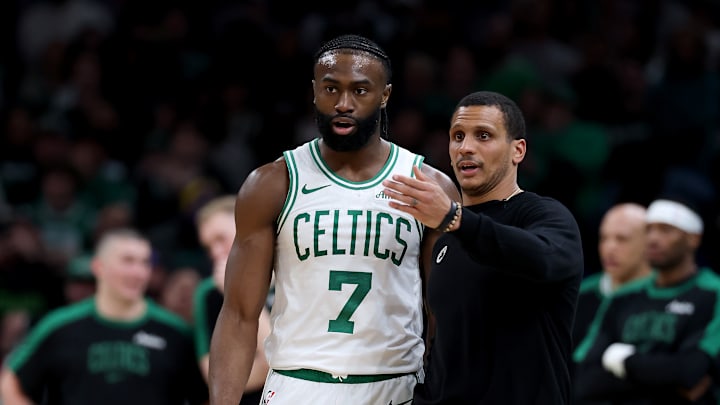After Jayson Tatum suffered a devastating Achilles injury, the Boston Celtics underwent a summer of change. The Celtics cut $300 million off their payroll and luxury tax bill while getting below the dreaded second-apron. Losing Kristaps Porziņģis, Jrue Holiday, Luke Kornet, and Al Horford, paired with Tatum's injury, puts the Celtics in a vastly different position than they have been in over the previous several seasons.
The ceiling for this Celtics team is now a playoff team, which is a big change for the 2024 champs. Some believe that the Celtics will fully lean into the "gap year" and position themselves for the draft this season. However, by all accounts, the organization hopes to remain competitive. Let's dive into the Celtics' depth chart and some questions that will determine their season.
Traditional depth chart
Position | Player | Player | Player | Player |
|---|---|---|---|---|
PG | Payton Pritchard | Anfernee Simons | Max Shugla (TW) | |
SG | Derrick White | Baylor Scheierman | Hugo González | |
SF | Jaylen Brown | Jordan Walsh | RJ Luis (TW) | |
PF | Sam Hauser | Josh Minott | Xavier Tillman | |
C | Neemias Queta | Chris Boucher | Luka Garza | Amari Williams (TW) |
Modern depth chart
- Guards: Payton Pritchard, Derrick White, Anfernee Simons, Max Shugla
- Wings: Jaylen Brown, Sam Hauser, Baylor Scheierman, Hugo González, Josh Minott, Jordan Walsh, RJ Luis
- Bigs: Neemias Queta, Chris Boucher, Luka Garza, Xavier Tillman, Amari Williams
Can Boston's center rotation hold up?
Looking at the Celtics roster, perhaps the biggest thing that stands out is a lack of quality big man play. The Celtics traded Kristaps Porziņģis to get under the second-apron. Additionally, they were priced out of re-signing Luke Kornet and (likely) Al Horford. To replace these players, the Celtics signed Luka Garza and later Chris Boucher.
Garza is a talented offensive big man, but he provides virtually no defensive value and has only averaged more than 10 minutes per game once in his four-year career. Boucher provides solid energy and inside scoring, but it's unclear how significant a role he can handle.
As a result, the Celtics will be counting on Neemias Queta to have a breakout season. Queta's hypothetical skill set, as a rim runner and rim protector, offers plenty of intrigue, but he's still raw on both ends of the court.
On paper, this is one of the worst big man rotations in the league. However, it's possible they exceed expectations, particularly if Queta takes a jump. The Celtics' production from their big men will greatly influence whether they can compete for a playoff spot or are forced to lean into tanking.
Can the Celtics field a component defense?
Something that is directly connected to their center rotation is whether Boston can maintain at least a league-average defense. Notably, the Celtics have posted a top-five defense for the past four seasons. While a top-five defense is out of the question, it's worth wondering if they can find a way to even be close to the league average.
In addition to wondering if the Celtics' big men can anchor their defense, the drop-off between Holiday and Anfernee Simons must be mentioned. Going from one of the best and most versatile perimeter defenders to one of the league's worst defenders will undoubtedly be problematic.
In general, the pairing of Simons and Payton Pritchard, who are similar players, will be interesting to watch. Tatum, in his own right, is an elite and versatile defender, which leaves the Celtics with yet another void.
While Brown and White are still All-Defensive caliber players, the Celtics don't have many proven defenders outside of those two. Boston still has a path to remain an above-average offense, but it's unlikely the same can be said for their defense, and they very well could be within the bottom five. If their defense is truly awful, it could hinder them from making the playoffs, even in a weaker Eastern Conference.
How will Jaylen Brown adjust to being the first option?
One of the more intriguing parts of the Celtics' season will be how Brown adjusts to being the first option. This aspect of the season I'm more optimistic about. Throughout his career, Brown has stepped up without Tatum, averaging 27.3 points, 7.1 rebounds, and 3.9 assists. Of course, the roster is far different from the previous times Boston has been without Tatum. Nevertheless, the 2024 Finals MVP has all the makings of a No. 1 option.
Brown will undoubtedly have more responsibilities as a defender, playmaker, and creator than ever before. It will be worth watching how Brown reacts to increased pressure from the defense, especially with a less talented roster around him.
Still, Brown has proven he can provide all of those skills. Yes, even playmaking, Brown averaged a career-high 4.5 assists last season. Without Tatum, this number may increase, and his points per game are closer to that 27 ppg range. Brown, entering the season fully healthy, is a reason for optimism, as last season he battled a knee injury.
If there's one reason for optimism about the Celtics' season, it's that they still have a top-five player in the conference.
